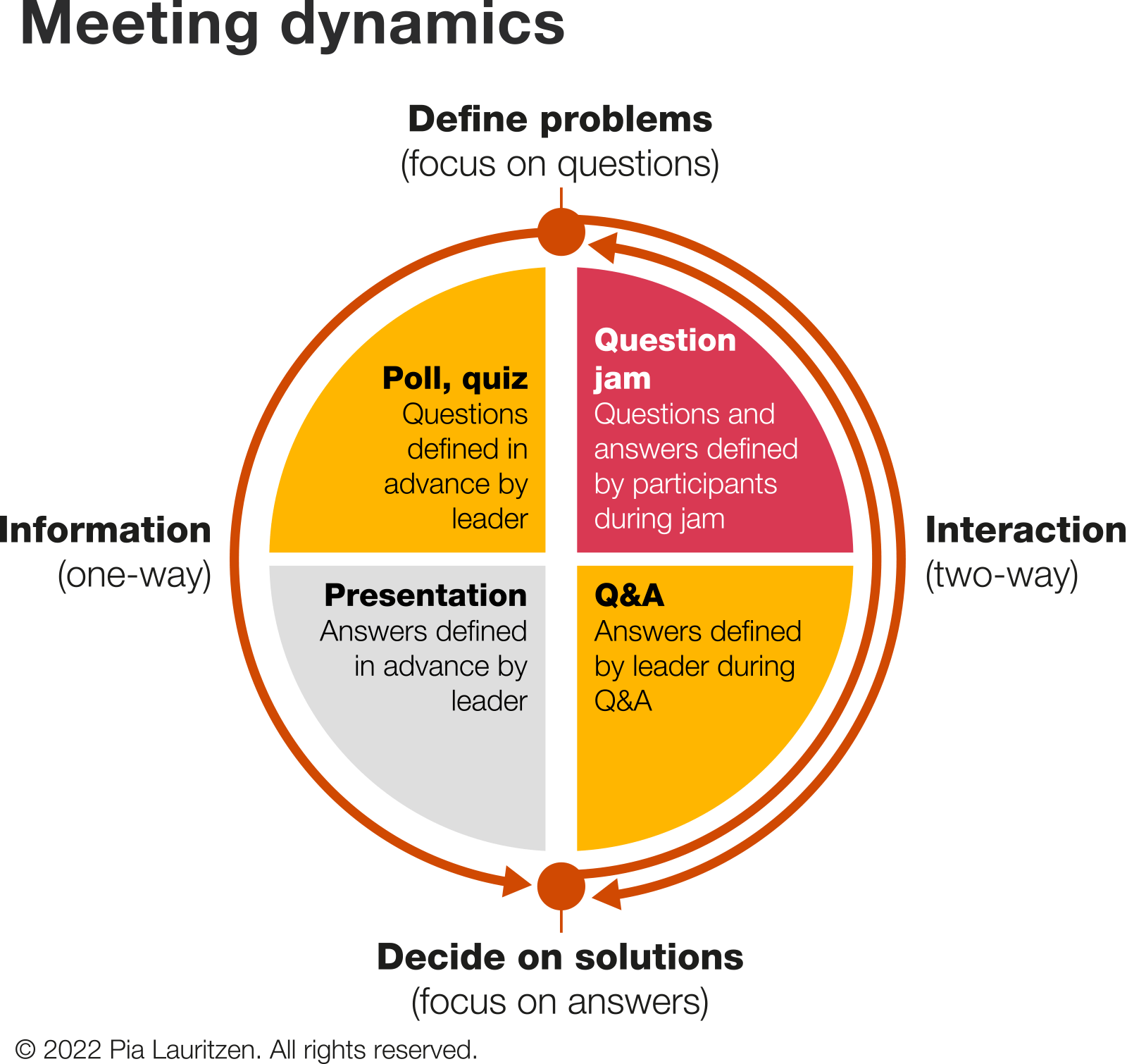Turn your meetings into jam sessions
Opening meetings with free-form questions that participants can answer on their phones or laptops can ignite people’s curiosity and boost engagement.

“A little less conversation, a little more action,” Elvis Presley sang in a 1968 hit. It’s a refrain common to most business leaders, who are often trapped in unproductive back-to-back meetings. Everyone hates meetings. In fact, in 2018 a Harvard Business School study found that CEOs spend 72% of their total work time in meetings, but think they are a waste of time. Meetings matter, though, because they are where you can tap into what I call collective curiosity. When people are curious together, they learn from one another and collaborate on solving their shared problems.
One of the things that distinguish us humans from other creatures is that we know that we don’t know everything. That makes us curious and eager to learn, and it also makes us turn to each other for insight and inspiration. If you think of meetings in that way, you can structure them to achieve productivity and engagement. That’s where question jam sessions come in: painless, brief, silent sessions that use people’s own questions and answers to connect them with one another and energize and engage them in the meeting agenda. These sessions are a way to collect what is on people’s minds about the topic of the meeting. And a question jam session takes just seven minutes.
The why of meetings can be shown visually. Most focus on using one-way information to achieve one common perspective (shown on the left side of the figure below). Getting the exchange of diverse insights and interactivity needed to make meetings successful requires a greater focus on the figure’s right side.
Question jam sessions are different from what happens in the top left quadrant and even in the bottom right. In a poll or a quiz, both questions and answers are predetermined by the meeting leader, which makes it a one-way information activity focused on the questions the meeting leader considers important. In a Q&A session, participants decide themselves what questions they want to ask, which makes it a two-way interaction activity focused on the meeting leader’s answers. The primary relationship in both types of activities is between the meeting leader and the meeting participants. That means that polls, quizzes, and Q&A sessions aren’t designed to foster the one-on-one connections among meeting participants that studies show are vital if people are to feel their time together is meaningful. Presentations, in the bottom left quadrant, are by definition one-way.
To facilitate and test the power of question jams, my organization is using a virtual tool that is as simple as it is effective (see figure below). It can be done both in person and virtually, though participation will be online to create the final word cloud that highlights people’s top priorities.
According to Malene Krohn, senior vice president at SimCorp, a Danish company that provides software and services to financial institutions, jamming helps meeting participants “extract learning and build on each other’s perspectives and experiences.” Krohn recently had a question jam session with a group of 12 leaders who had come together to find out how to be successful in strategy execution. After the jam sessions, the leaders realized they wanted to explore their different perspectives and look for patterns in the word cloud as a way to investigate alternative approaches and consolidate their views before making any key decisions.
Although no one speaks during the seven-minute jam session, Krohn said that “everyone gets a chance to be heard,” because people don’t waste a lot of time waiting for one another to contribute. They are in dialogue simply by answering the questions others are asking and posting their own questions. Participants can identify themselves when asking questions, or be anonymous.
Research by Harvard Business School professor Francesca Gino shows that being curious leads us to make fewer bad decisions because we are less likely to fall prey to confirmation bias and to stereotyping people when we are curious. In her article “The Business Case for Curiosity,” she explains that “curiosity leads us to generate alternatives.” And the ability to generate alternatives is closely related to what leaders crave: more innovative and positive change, reduced group conflict, more open communications, and better team performance.
According to Wayne Mack, general manager of business transformation at Bass Coast Shire Council, a local government office in Australia, the jam-session approach helps focus people’s attention on what matters. Once you put on hold the assumption that meetings are about talking and invite everyone to silently and simultaneously exchange questions and answers in writing, “everyone is forced to think in the moment,” as Mack put it.
We are all curious and eager to learn, but we are not curious about the same things. So if a meeting leader wants more engaged and productive meetings, she has no choice but to pay attention to the questions her meeting participants are asking, and the problems they are already trying to solve. Bill Gates has been quoted as saying, “You have a meeting to make a decision, not to decide on the question.” Whether he said this or not is not the point. The important thing is that it is wrong. If people don’t agree on what problem to solve, the decisions they make to solve it will have no impact.
In Curious Minds, a recently published book by twins Perry Zurn and Dani Bassett, the former a researcher in political philosophy at American University in Washington, DC, and the latter a professor of physics, engineering, neurology, and psychiatry at the University of Pennsylvania in Philadelphia, curiosity is described as a practice of connection: “It connects ideas into networks of knowledge, and it connects knowers themselves, both to the knowledge they seek and to each other.” Combining the notion of curiosity as the ability to generate alternatives and the practice of connection suggests that curiosity is as much a collective process as it is an individual one. To stay in the jam vocabulary, curiosity works just as well for bands as for soloists—if not better.
As in a band, jamming is not something you do to avoid following a meeting agenda (playing according to notes). Rather, it is something you do to create the energy and feeling of belonging that’s needed for everything else to work. To solve problems no one can solve alone, we must build on one another’s experiences and insights—and the best way to do that is to ensure that everyone’s unique perspectives are brought into play before the groupthink kicks in.
As in a band, jamming is not something you do to avoid following a meeting agenda, but something you do to create the energy and feeling of belonging that’s needed for everything else to work.
By having question jam sessions at the beginning of their meetings, leaders can help participants tune in to a shared problem and at the same time surface different ways of approaching the problem. To paraphrase Elvis, people working in organizations want less information and more interaction. But they don’t want interaction for the sake of interaction. They want to connect and interact in a way that’s meaningful to them and valuable to the job they are doing.







